Whether you are going to start a new recording studio or you already have one, it’s important to know all about the essential recording studio equipment to grow from your tiny bedroom studio to a professional one.
When you see the pics of those professional recording studios on social media feeds, you dream about upgrading your own just like them.
However, it all depends on your budget. But any business starts small and expands with time. It takes time to develop your skills, get clients and then reinvest in your business.
The recording studio is not an exception. With time you should upgrade your professional recording studio setup from a bedroom studio to a professional one.
This article will guide you all about the recording studio equipment list you need on this journey.
Table of Contents
- 1 Recording Studio Equipment List
- 2 4 Types of Recording Studios
- 3 Essential Items for Bedroom Studios
- 4 Essential Home Recording Studio Equipment
- 5 Semi-Pro Recording Studio Essentials
- 6 Professional recording Studio Equipment List
- 7 Wrapping Up: Recording Studio Equipment List
- 8 FAQs on Recording Studio Equipment List
Recording Studio Equipment List
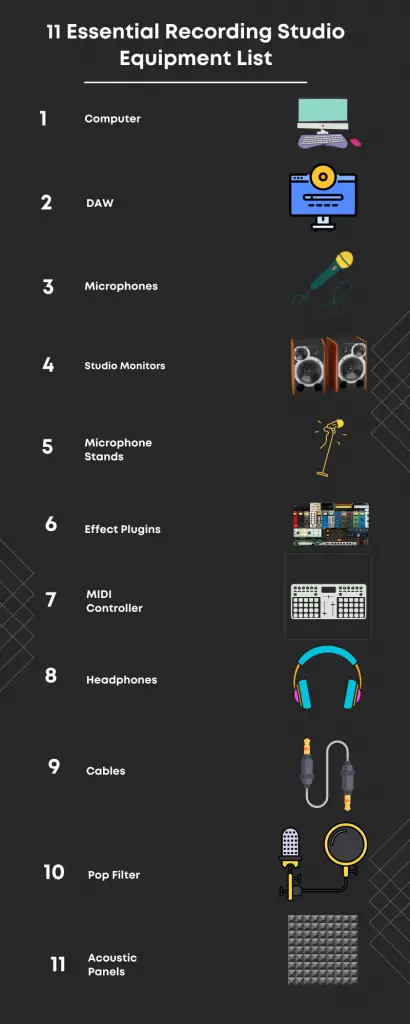
It’s crucial to know when you need the right equipment for the recording studio.
In the earlier stages of my career as a recording engineer and music producer, I made some wrong decisions when purchasing the equipment for my studio.
The one wrong decision was purchasing Yamaha Digital Mixer at the very first stage when I was just starting out. It took $2000 which was a huge amount for me in those days.
Disclosure: This post may contain affiliate links, which means we may receive a commission if you click a link and purchase something that we recommended. Read more about Affiliate disclosure here.
However, I can also record the same quality music with my Motu 898 MKII audio interface as there were all the inputs and outputs available with a great ADA converter and preamps.
Due to the lack of information, I purchased the Yamaha Digital Mixer at that stage when I didn’t really need that.
So, you should always know which music production equipment is right in which stage of your recording studio.
there are 4 types of recording studios that exist.
I have listed all the required music recording equipment in a studio as per the types so that you could get help when you are going to start a new one or upgrade your exciting one.
Before digging into the list let us get some information about those 4 types of recording studios…
4 Types of Recording Studios
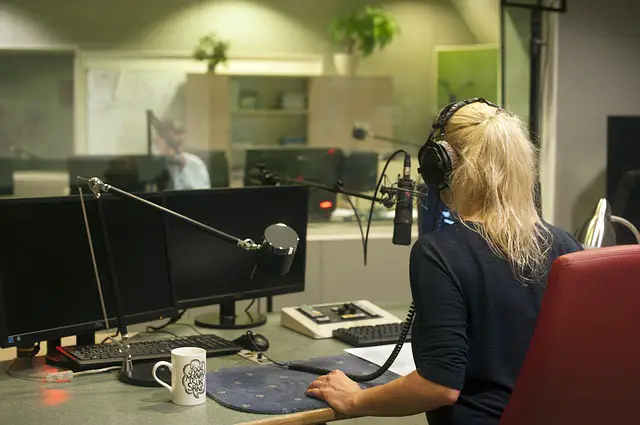
- Bedroom Studio
- Home Studio
- Semi-Pro Studio
- Pro Studio
1. Bedroom Studio
It’s a very basic type of studio which you can set up on the table next to your bed.
In this type of studio, you just need some basic music studio equipment to record vocals, make beats, etc, and produce indie music.
This only needs a laptop, an audio interface, and a decent mic to record and produce audio right next to your bed.
Here, I want to tell you that you can’t expect great audio quality because it’s actually an unprofessional way of audio recording.
However, bedroom studios are quite popular among songwriters and indie producers. So, if you are just starting out then you can go for it to learn the basics.
Now come to the second one…
2. Home Studio
Home studios need an extra room solely for recording and producing music.
It can be your abandoned garage or a 10’x12′ guest room. It needs some acoustic treatment along with some extra studio recording equipment such as an audio interface, mic, and computer.
This also includes some furniture to get into work.
Home studios are the most popular ones. After all, anybody can arrange a 10’X12′ room. It’s not that hard to get into it with just one separate room.
And the best thing is, you can also do some acoustic treatment experiments in that room. As compared to a bedroom studio, it’s a far better approach.
Semi-Pro Studio
Home studios generally don’t have the ability to record multiple musicians simultaneously. Here come the Sem-Pro studios.
These types of studios can be set up in your home with more than one room or in a commercial place.
Semi-pro studios are equipped with the home studio equipment necessary to record multiple musicians simultaneously.
Pro Studios
these are professional studios located in a commercial place and equipped with the tools necessary to produce professional results just like Hollywood projects.
These types of studios need millions of dollars to establish because, from the acoustic treatment to the hardware, it needs huge money.
Now let us dig into the list of what exactly is required in each of these 4 stages.
Essential Items for Bedroom Studios
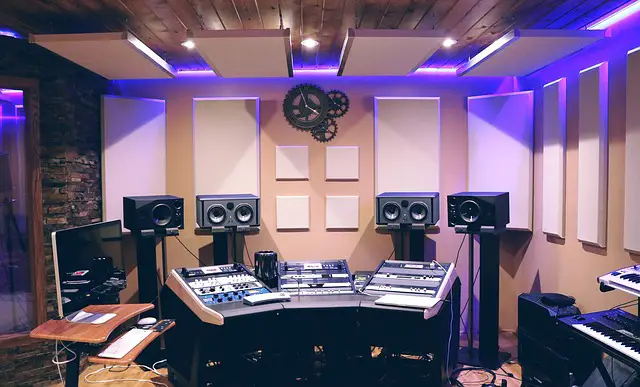
This is the very first stage in the journey of a recording studio. When the worm of music bites you, the bedroom studio starts.
Many of us come into music hobbyists. Some of us make it our profession but a big part of us take it as a hobby and just need a small platform to record our own creations.
However, in the old days, the concept of bedroom studios did not exist. In those days, audio recording needed huge mixers and effect panels.
So it was not possible to have one in your bedroom.
Today, technology is totally changed. Like other professions, Audio recording is transformed into the digital domain.
Now it’s very easy to set up a tiny studio on the table next to your bed. You just need the following audio recording equipment to start a quality studio from your bedroom.
Have a look at them…
- Computer
- DAW
- Audio Interface
- Microphones
- Headphones
- Studio Monitors
- Cables
- Microphone Stands
- Pop Filter
Now let us get some detailed information for the same.
1. Computer

As you know the audio recording is shifted from analog to the digital environment, the very first equipment you need is a computer or laptop with good configuration.
However, you can also use your old computer and save a few bucks but keep in mind today’s DAW’s more hardware resources which maybe your old computer can’t handle.
So I suggest always going with the latest configuration available in the market to get good results.
Although the latest hardware configuration is preferred, you can go with some low models if you don’t have the amount to buy the latest model.
Before purchasing a computer and laptop, you should always check the minimum system requirement in the DAW manual that you are going to use.
Also, check the requirements for the VST instruments as they need huge processing power. If you missed checking for the VST instruments requirement, you can face trouble somewhere between the recording session.
Here are some examples of good latest configuration computers and laptops.
2. DAW (Digital Audio Workstation)
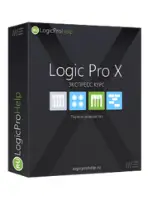
DAW or digital audio workstation is the software that makes it possible to record audio in the digital environment.
Just as in the old days analog mixing boards were used as music studio equipment, you can say they are the digital version of the system.
DAW is the software that provides us with the digital recording environment with the help of an audio interface and other digital recording equipment.
In DAWs you can record, edit, mix, and master your projects on your computer.
You are provided with a workspace, audio, and MIDI tracks where you can record and edit your projects.
As well as DAWs are equipped with a mixer window and pre-loaded audio effects to provide you with the best digital recording environment. So we can say them the digital version of mixing consoles.
Pro-Tools is considered the top DAW in the world but there are so many best options to choose from.
Here are 2 guides that help you to choose the suitable DAW for your studio and of course your pocket.
3. Audio Interface

The next thing after getting the DAW is the Audio interface. Audio interfaces provide all the necessary input and output connections to the computer and make it able to interact with the DAW.
Although, there are many other functions audio interfaces incorporate such as,
- Input connections that send the mic and other signals to the computer.
- Output connections from the computer to the monitors
- digital conversion (AD/DA)
- mic preamps
- DI boxes
- headphone amps
- Monitor outs
In pro studios these all things are done by separate equipment and devices however in the bedroom and home studios audio interfaces are the all-in-one equipment for recording.
Read this blog post to know more about audio interfaces and the best recommendations.
My Recommendations
- BEHRINGER U-PHORIA UMC202HD, 2-Channel (Bedroom Studio)
- Yamaha Steinberg UR22MKII 2-Channel USB Interface (Bedroom Studio)
- Focusrite Scarlett 18i20 USB Audio Interface (Home Studio)
4. Microphone
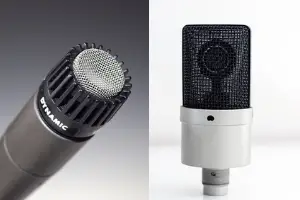
Microphones are one of the most essential equipment used from bedroom studios to professional studios.
Without a microphone, you can’t record vocals and other acoustic instruments. So these are one of the most important ones in the recording studio equipment list.
There are several types of mics that exist for different types of works. However, if you are just starting out from the bedroom studio, you just need a good dynamic mic for the very basic vocal recordings.
Or,
If you want to know more about different types of microphones refer to this article.
You can also read this article to choose the best ones for your budget.
My recommendation
5. Headphones
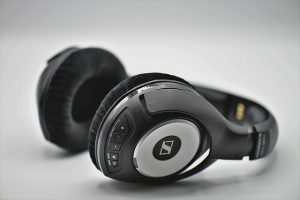
So, headphones are the devices we all use in our day-to-day life.
Right,
Well, studio headphones are far different from the consumer headphones that we use in our daily life.
Those are only made to provide as flat frequency responses as possible and do not modify the sound. This is what we need in audio mixing. Any modification in sound can ruin the mix.
However, headphones are not necessary for bedroom studios, you can own them if you don’t want to disturb your neighbors.
there are three types of studio headphones that are used for different tasks.
- Closed-back headphones – Vocal chamber
- Open Back Headphone – Mixing
- Semi-Open Headphone – Monitoring
You can refer to these guides for better knowledge of headphones.
My recommendation
6. Studio Monitors
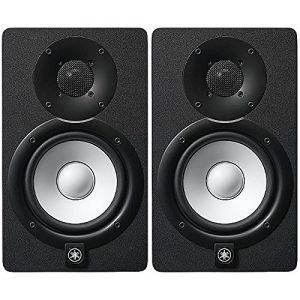
Whether it’s a bedroom studio or a professional one, we can’t rely just on headphones for output. Studio monitors are an essential need for all types of studios.
They provide you with the sound that you need to monitor and get a better quality mix.
Studio monitors are of two types,
- Near-Field Studio Monitors
- Far-Field Studio Monitors
For a better understanding of near-field and far-field read Near Field Vs Far Field Studio Monitors.
In the above guide, you will find all the information about these two types of monitors and also know why near-field monitors are good for home studios.
Monitors are more costly than headphones so if you are starting from a bedroom studio you can skip this equipment. But keep in mind as compared to headphones monitors provide a better output for mixing.
The other important thing you need to know is that using studio monitors requires some sort of acoustic treatment otherwise reflections occur and you won’t get an accurate sound.
Check out these blog pots on studio monitors,
My Recommendation
7. Cables
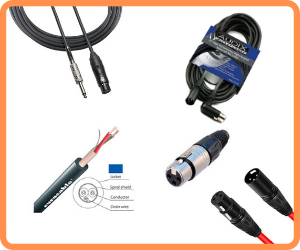
Cables are essential for each type of recording studio. In pro studios there are hundreds of cables are used for several different works. However, for bedroom studios, you don’t need many.
The 2 that you really need are,
- XLR cable for your mics
- 2 Phono cables for your studio monitors.
In this journey from bedroom to pro studio, you will encounter several other types of cables. Some of them are,
- Optical cable
- Wordclock cable
- Digital RCA
- Analog RCA
- Instrument phono cables
- Balanced phono cables
- Headphone connectors
- and many more…
8. Microphone Stands
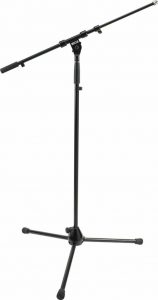
You can use your microphone holding it in your hand…But
There is a fair chance you get some rubbing sound in the recording which occurs by the friction of your hand with the mic.
So what’s the heck??
Using mic stands. Again mic stands come in several shapes and sizes built for specific tasks in recording studios and live sound. For bedroom studios, you just need one or two and get more as you transform your studio with time.
My Recommendation
9. Pop Filter

Pop filters are used with mics to filter the popping that comes out from the vocal. In some alphabets such as P, PH, etc a popping effect occurs due to increased air pressure in the mouth.
The intensity of popping is greater than the original voice so it interrupts the original vocal.
Pop filter scatters the increased air pressure and minimizes this effect. So whether it’s a bedroom studio or a professional one, if you want to record vocals, pop filters are essential.
Keep in mind that always go with high-quality pop filters as low standard does not guarantee the full elimination of popping.
Now here comes the second type of recording studio. Many of us are satisfied with our bedroom studios and keep it as a hobby.
Few of us want to transform it. And at this stage, we need to know some other professional recording studio equipment that we need to transform our bedroom studio into a home studio.
So, let us get into the list…
Essential Home Recording Studio Equipment
Bedroom studios are just for hobby purposes. But if you really want to record serious music you would have to upgrade your bedroom studio into a home studio.
Recording and producing professional music from your bedroom is not possible.
You need at least a dedicated acoustically treated room where you can arrange the following recording equipment to start your home studio.
So let me show you the list of studio equipment list that you need for your home studio.
- Desktop Workstation
- Effect Plugins
- VST Instruments
- Studio Chairs
- Bass Traps
- Acoustic Panels
- Diffusers
- Reflection Filters
- Monitor Isolation Pads
- Studio Monitor Stands
1. Desktop Workstation
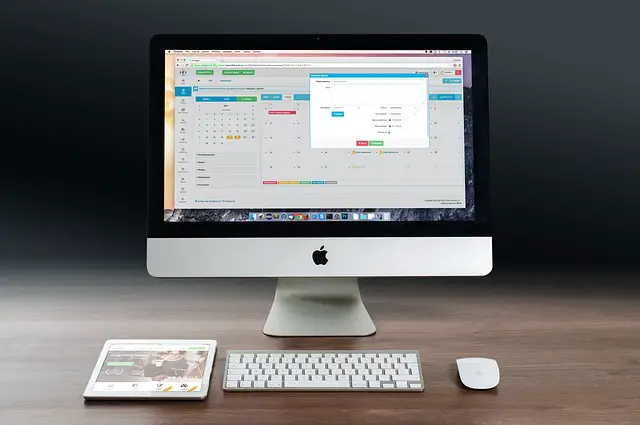
When we transform from a bedroom studio to a dedicated home studio the first thing we should optimize is the computational power of our computer.
Obviously, you will transform your bedroom studio into a home studio because you are getting more work.
More work means more tracks and VST instruments and ultimately more load on your computer. So my very first advice is to buy a dedicated desktop workstation for your home studio with as higher a configuration as you can afford.
After all, in digital recording, the computer is the hub for all connected devices. If you don’t choose the right one, chances are you will get in trouble somewhere between the work.
So what is the best computer for a home studio?
I always support an iMac with at least a Core i5 processor and 16 GB RAM. However, if you can’t afford iMac go with an assembled PC with the same configuration.
My recommendation
2. Effect Plugins
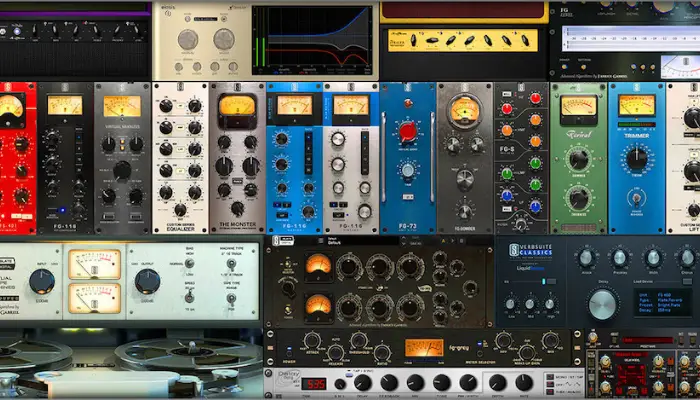
In Bedroom studio effect plugins are optional, as you already get some in-built effect plugins with your DAW which are enough for bedroom studios, yet when you upgrade your bedroom studio to a home studio, you need some extra plugins.
In-home studios, there would be different kinds of projects you get. You can’t rely on just the DAWs default plugins to execute the process.
You need some extra plugins, such as Autotune for vocals pitch correction, Dedicate reverb and delay plugins, and some good dynamics plugins.
If you want to get the best plugins for your home studio then read these articles,
- 14 Best Free Reverb Plugins For Home Studios
- FabFilter Pro Q3 | Amazing EQ Plugin With Dynamic EQ, Solo Mode
- recordingbase.com/audio-plugins-guide
3. VST Instruments
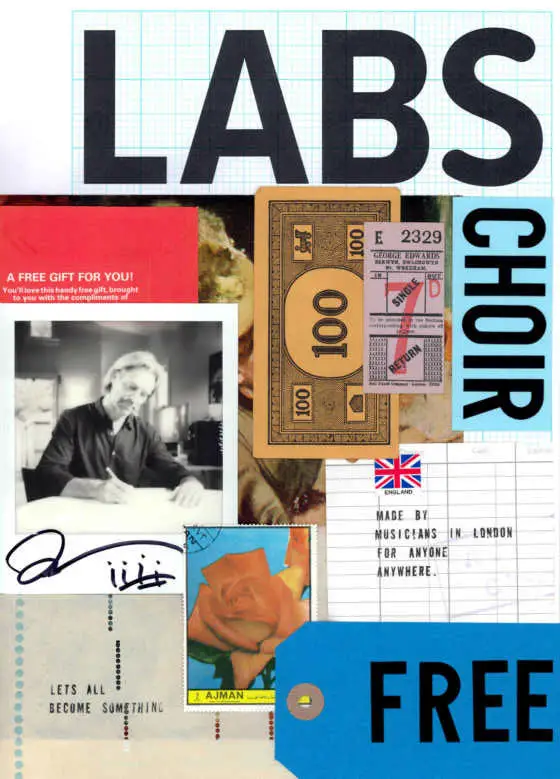
In the old days were needed specialized musicians for different types of instruments were. But today technology has changed.
Now we need VST instruments for different types of instruments and a MIDI controller or Keyboard to play the instrument through that.
When you are in the bedroom studio step, you don’t need to invest in VST instruments, but in the case of home studios, you really need at least a few.
Such as a bass guitar, electric guitar, sax, strings, etc so that when the musician is not available you can fill the gap by playing the instrument with your MIDI controller.
Even, most of the music producers today are one-man army producing music with VST instruments, loop, and samples.
The best place to buy VST instruments is PluginBoutique and Loopmasters which I always suggest to my readers.
4. MIDI Controller
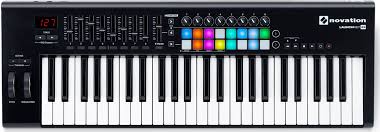
to play VST instruments you need MIDI keyboard controllers in your studio. These are just like keyboards but don’t have their own tone.
You can connect your MIDI controller with the VST instrument to get the tone.
Nowadays MIDI controllers are very common instruments in most homes studios. These instruments make us a one-man army and make us able to produce music with just our own efforts.
MIDI controllers are an important part of home studios and you can’t skip them.
My recommendation
5. Studio Chairs and Tables
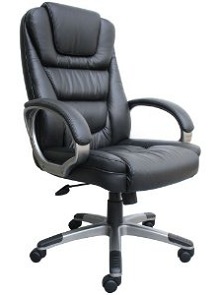
When you upgrade your bedroom studio to a home studio, you need some extra furniture such as chairs, tables, and some decorating items.
But the most important thing is when you choose the chair for you as a recording engineer, make sure it’s comfortable enough to sit for hours. Otherwise, there will be lots of trouble you gonna face.
Studio recording is a sit-in-one-place skill so you have to be prepared to work for hours sitting in the chair. So always choose the good furniture for your home studio, especially the chair on which you will sit.
6. Bass Traps
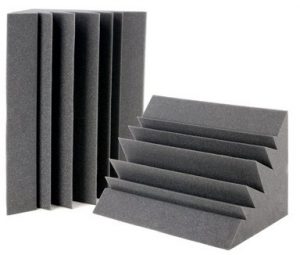
As I have derived in my article Ultimate Guide To Acoustic Treatment For Home Studios
most of the sound energy gathers in one place of the room that is the corners. Especially the low-frequency sound(bass) gather at the corners and multiply 3 times which is enough to spoil your recording.
If you don’t treat the corners well, you will face bad recording experiences. Most of us don’t know the basics of acoustic treatment and simply avoid this matter.
The 1st and most important rule of sound treatment is to cover the corners with some type of acoustic material such as BASS TRAPS.
Bass traps are specially built for this problem and absorb most of the low-frequency sound energy that gathers at the corners of the room. Bass traps are available in many qualities but you need the best one.
Wondering, which is the best one?
My recommendation
7. Acoustic Panels
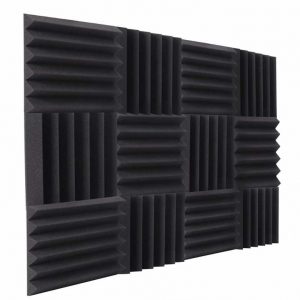
After bass traps, the second important acoustic treatment item is Acoustic panels. They are glued on the walls to scatter and observe the sound reflections and prevent them to come into the mic as well as mixing into the monitor’s sound.
They come in several shapes and sizes. All you need to examine your room and then search for the best size and shape.
However, buying sets is always cheap and better than buying them separately.
My Recommendation
8. Diffusers
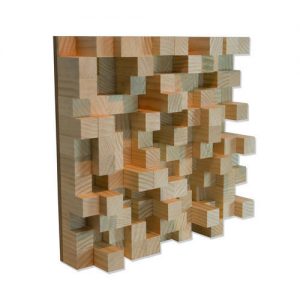
Diffusers are another type of acoustic panel that is especially used to diffuse sound reflections and keep your room clean from unwanted reflections.
You can set up them just behind you on the wall so that the sound directly coming from the monitors collide with the diffusers and does not come back to the monitor system.
As diffusers are made of wooden material and need some extra work they are more costly than bass traps and acoustic panels.
However, if you have a budget you can use them in your home studio for better sound treatment.
My Recommendation
9. Mic Reflection Filters
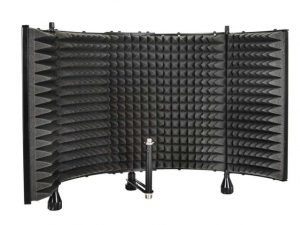
Sometimes it would be expensive for small home studios to bear the cost of acoustic treatment. If you have started your home studio for doing some vocal recordings you can use a cheap alternative to the acoustic treatment.
Mic Reflection filters
These are acoustic pads that can be fitted on mic stands alongside the mic and help to absorb the sound reflections at the time of vocal.
Really a cheap alternative to expansive bass traps, acoustic panels, and diffusers.
My recommendation
10. Monitor Isolation Pads
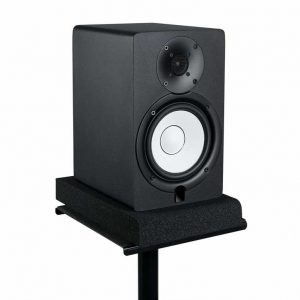
When you directly place your studio monitors onto the table, the sound vibrations transfer to the other stuff and create unwanted resonance. These resonances mix up with the original sound of monitors and reduce the accuracy of the monitors.
Monitor isolation pads act as vibration absorbers and prevent the vibration from transferring to the desk.
they are built with a special rubber material. They are cheap in price and you can easily afford them. I always suggest my readers use monitor isolation pads for accurate sound.
My Recommendation
11. Studio Monitor Stands
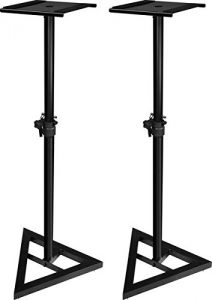
As you know the positioning of studio monitors matters a lot in mixing. You can’t accurately position the distance, height, and angle of your monitors by relying on your desk.
So I would suggest you use monitor stands which are fully adjustable when it comes to positioning your monitor’s distance, height, and angle.
With the help of a pair of monitor stands and an SPL meter, you can easily get the best position for your monitors.
And ultimately deliver the best possible sound quality.
My recommendation
So here you’ve gone through all the necessary equipment needed for a decent home studio.
Now come to the 3rd stage of transforming.
Semi-Pro Recording Studios.
Somewhere in the journey, you will feel like you need something extra in your studio, and at that time you have to upgrade your recording studio into a semi-pro recording studio.
In the next section, we will learn about some extra studio essentials needed in a semi-pro recording studio.
Let’s dig into…
Semi-Pro Recording Studio Essentials
So, as we are already aware of that thing we need extra inputs and space to record more instruments simultaneously, which is not possible with homes studios.
In this situation, you need more space in your room and more input in your audio interface.
Suppose, you want to record a whole drum set in your home studio and you only have a 4-channel audio interface so how could you connect the 8 mics used in recording drums?
Or, think about the space needed to record the whole set of drums.
there are so many things that you need at some point that upgrade your home studio into a semi-pro studio.
Most of them are listed below.
- Rack Mount
- Power Conditioner
- Microphone Preamp
- Headphone Amp
- Monitor Management
- Electronic Drum Kit
- Control Surface
- Analog Emulation Plugins (UAD Powered Plugins)
- Snake Cable
- Uninterruptible Power Supply
- Direct Box
1. Rack Mount
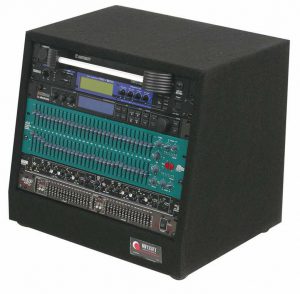
The one thing you see common in all professional recording studios is rack mount. Rackmounts are the advanced version of the desktop audio interface and effect system.
A rack mount with some good effect processors and audio interfaces costs thousands of dollars. Having one is like a milestone for your studio.
The advantage of rackmount systems is you get all the professional needs inside one rack. Such as effect processors, audio interfaces with several inputs that help you record large bands, mastering suites, and many more.
It’s just like the whole thing is under one roof.
When you want to upgrade your home studio into a semi-pro studio, a rack mount system is the very first thing you need to go more professional.
My Recommendation
2. Power Conditioner
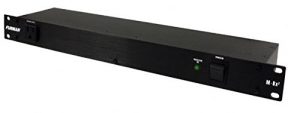
When you are ready to play with some very costly equipment its crucial to filter the electrical power so that you can save those from,
- surge
- High voltage
- noise
Here power conditioners get to work.
They are an important part of your rack mount and provides
- Surge protection
- Voltage regulation
- Noise Filtration
Which ensures the life of your equipment.
The other benefit of power conditioners is you can handle all the power needs of your rack mount with just one device.
Power cables of all the equipment connect with the power conditioner and only one cable connects to the wall socket.
A huge benefit…CLEAN recording studio.
Classic example
3. Microphone Pre-amp
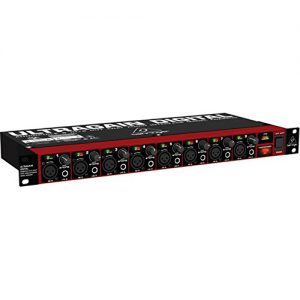
In the semi-pro recording studio stage, the pre-amps of your audio interfaces are not enough to record a whole band. You need more preamps to operate more mics simultaneously.
Here comes the need for dedicated mic pre-amp equipment. Mic preamp devices come with a minimum of 8 in the count which is far more than your audio interface.
If you still need more preamps you can go for 16 channels or 32 channel mic pre-amps.
The other benefit of using mi pre-amps is you get more quality in your recordings. With the high-end mic pre-amps, you get a more accurate sound which helps get a more professional mix.
My Recommendation
4. Headphone Amp

Recording more instruments simultaneously needs more headphones. That means more headphone-out connections in your audio interface. Unfortunately, not all audio interfaces have more than two headphone outs.
Here you need a headphone amp. Headphone amp provides 4 and more headphone outs so that you could avail the headphones to all of your musicians during recording.
The other benefit of headphone amps is you can separately adjust the volume for all the outputs.
I have two headphone amps in my studio which help me to connect 8 headphones at a time.
My Recommendation
5. Studio Monitor Management System
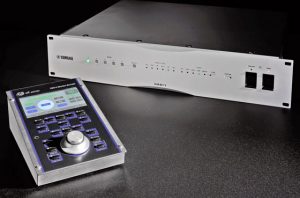
If you’ve ever been in a semi-pro studio you would have seen they use multiple studio monitors. Do you know why?
Actually, engineers listen and compare the mix in different monitors to be clear that the mix would sound good in consumer speakers. In some studios, consumer speakers are also used for the final listening.
Monitor management systems provide a switching solution for different types of monitors. You can connect all your monitors to the system and listen to one by using a switch.
So if you have more than one pair of monitors in your studio, sure you should get a monitor management system.
My Recommendation
6. Electronic Drum Kit
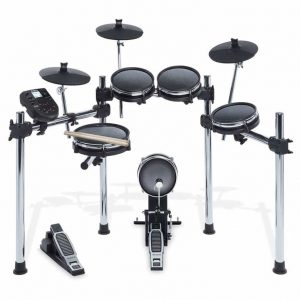
Now let us come to one essential instrument that you always need in your Semi-Pro studio.
- Electronic Drum Kit
While you can produce beats with VST instruments via MIDI keyboard this is not practical when it comes to drummers.
Drummers have their hands on acoustic drums and when they get into MIDI keyboard production it becomes very hard for them to deliver the same quality.
Here you can use electronic drum kits. These are awesome in some ways drummers like. Such as they are just an electronic version of acoustic drums. That means they can freely play the beats.
But when acoustic drums are already there why would you use an electronic version?
Because sometimes in the recording studios, the acoustic drum doesn’t fit with their loudness and the difficulty in the recording.
Electronic drums make your work a lot easier.
My Recommendation
7. Control Surface
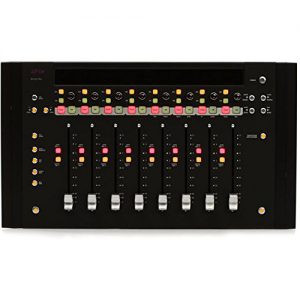
If you have operated your DAW mixer with a mouse and keyboard, then you already know how difficult operate faders.
Right?
As faders are the most important part of mixing and a slight up and down makes a big difference in the sound intensity, It’s very important to use control surfaces that help you to clone your DAW mixer as a hardware mixer.
This arrangement makes a big difference in mixing and you will realize it when you use it in your mix.
Control surfaces are the solution to this problem.
Read this article if you want to know more about control surfaces.
8. Analog Emulation Plugins (UAD Powered Plugins)
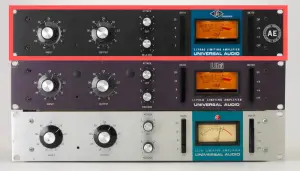
Instead, we are recording with digital equipment today many of us want the taste of old analog devices.
Digital recording technology is rapidly evolving though many of us still complain that analog recording sounds good.
Don’t worry,
There is a special type of plugin available in the market that adds analog taste to your digital recording.
ie;
Analog emulation plugins
These plugins are emulated from the original analog equipment and are able to give the same analog taste in your digital recording.
These are costly though you can use them at this stage when you are ready to upgrade your studio into a semi-pro studio.
Two of the most popular analog emulation plugins providers are
Above, I have recommended UAD-powered plugins, though it needs UAD plugin accelerator hardware to run on your computer, the precision UAD plugins provide waves don’t.
9. Snake Cable
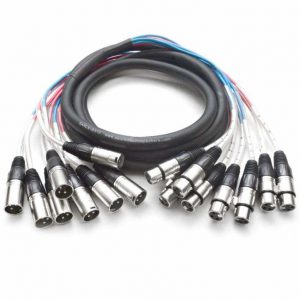
As more equipment is poured into your studio the more cables and wires scatter. and when it comes to semi-pro studios there are hundreds of cables that you will fail to arrange.
The best solution for arranging all the cables in a clean way is using snake cables.
Snake cable is actually a bunch of several individual cables attached in one master source which makes it far easier than individual cables to maintain snake cable.
Another advantage is it dramatically cleans up the look of your studio.
If you already have your own home studio then I know you are facing this big problem of arranging the bunch of cables behind your desk.
Using snake cables is the best solution for this.
However, snake cables are built for Semi-Pro and Pro studios you can search for one that fits your home studio.
My recommendation
10. Uninterruptible Power Supply
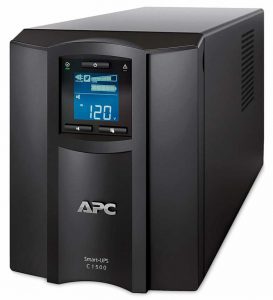
However, UPS or uninterruptible power supply is the thing that you need from the 1st phase ie; the bedroom studio but at the Semi-pro studio stage it’s crucial to get some serious UPS solution.
You just can’t rely on the same small UPS as your home studio.
As you have so much equipment to provide power which is simply not possible with the small UPS of your home studio you need the bigger one to manage all the power supply for all the equipment.
My Recommendation
11. Direct Box
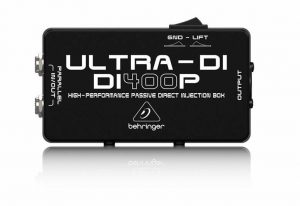
When you upgrade your home studio into a semi-pro studio, you probably have more acoustic rooms and a big control room than the previous one.
Simply the length of your cables also increased to reach the instruments in your acoustic rooms. Here you can face one problem ie; noise in the signal.
However, most of the audio interfaces have a built-in direct box to filter the noise from the signal but sometimes you need a dedicated direct box to do the same.
A direct box takes the (unbalanced) instrument-level signal and converts it to a (balanced) mic-level signal.
And at the end, you get the clean signal.
Here is my recommendation for the direct box.
Here comes the end of stage 3 – Semi-Pro studio. For most of us it’s the final destination of our recording studio career as we can easily record the whole band and produce professional audio.
But few of us want to go further. Here comes the concept of Pro Recording Studio.
Professional recording Studio Equipment List
Pro studios are fully professional recording studios and transform our studio to a Hollywood standard. 99% of us don’t have the budget to upgrade to that level thought you should know about the equipment needed to build a pro studio.
Here are some of the items of pro studios that you need to know about.
- Digital Converters
- Master Clocks
- Analog Effects
- Mixing Rack
1. Digital Converters

Digital converters are an important part of any digital device in your studio such as audio interfaces, digital effect processors, etc.
In home and semi-pro studios we generally don’t need a standalone digital converter but in pro studios where every aspect of quality counts you will find several dollars priced digital converters common.
Engineers in the pro studios are conscious about every small thing that increases the quality of the audio so they prefer to use standalone digital converters over the inbuilt ones in the audio interfaces.
One of them is
2. Master Clocks
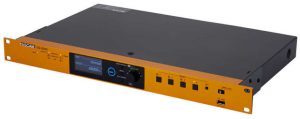
Every digital audio recording device has a clock called a word clock which should be in sync with other devices by master and slave format where the slave devices follow the master device’s word clock.
The difference in word clocks between the two devices creates unwanted pops and clicks. So it’s very important to connect the devices with a master device.
Master clock could be your audio interface device or you can use separately a master word clock to slave all the devices.
However, it’s a never ended debate whether a dedicated word clock device improves the audio quality or not but in pro-studios engineers don’t want to take any risks of losing the quality hence using world clock devices.
Here is one of them
3. Analog Effects
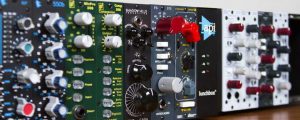
Till now we have encountered VST plugins that are good for project studios. But when it comes to pro studios, where each and every detail of audio is been considered, analog effect plugins make a big difference in quality.
The first and most important advantage of analog effect plugins is they provide much more analog test than every music producer wants in his recordings.
4. Mixing Rack
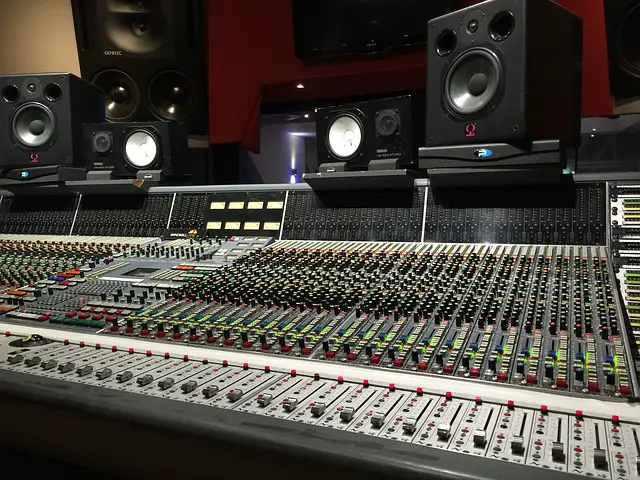
What are mixing racks? – Mixing racks are all one solution for recording and mixing for recording studios. From the 50s to the 80s mixing racks were very popular among professional recording studios.
Just as analog effect plugins, mixing racks make a big difference in audio. With more depth and an analog feel, it’s one of the most important pieces of equipment in pro studios.
As well as mixing racks provides a good look at the studio.
But they cost millions of dollars and are out of the reach of an average studio owner.
However, you can see these examples.
Wrapping Up: Recording Studio Equipment List
Alright, here was the ultimate recording studio equipment list for all types of recording studios. It’s not the end it’s the beginning of the journey. I wish you all the best in your journey of recording evolution.
Now it’s your turn to build your studio if you don’t have it till now.
This list will help you to choose the right equipment for your studio whether it’s a bedroom, a home, or a semi-pro studio.
If you already have a recording studio, comment below about your studio equipment. Your comment will help others to choose the right studio equipment.
Share this post on your social channels and help others to get into this business.
FAQs on Recording Studio Equipment List
What kind of equipment do I need for a recording studio?
The basic equipment that you need for a recording studio includes a computer, an audio interface, and microphones.
You will also need some software to capture and edit your recordings.
Having a digital audio workstation (DAW) is advisable, as it will give you more flexibility when recording and editing your audio.
How much does it cost to set up a recording studio?
The cost of setting up a recording studio will depend on the quality of the equipment that you purchase.
Expect to spend at least a few hundred dollars for a basic computer setup and audio interface.
For more advanced products, such as studio monitors and microphones, you can expect to spend several thousand dollars.
What are the basic things I need to know about setting up a recording studio?
The most important thing to keep in mind when setting up a recording studio is to create an acoustically-controlled environment.
This means that you need to use specialized soundproofing materials and techniques such as acoustic foam, bass traps, and so on.
You should also consider the size of the room, as a smaller room will help minimize reflections and echoes.
How do I choose the right recording studio equipment?
The best way to choose recording studio equipment is to consult with a professional recording engineer or producer.
They will be able to advise you on the products that will work best for your studio and specific recording needs.
You should also research online reviews of different equipment to learn about their performance and reliability.
What are the different types of recording studio equipment?
The most common types of recording studio equipment include audio interfaces, professional microphones, studio monitors, and digital audio workstations.
Other important products to consider include synthesizers, compressors, and audio plugins.
When purchasing equipment for your studio, it is important to ensure that all of the products are compatible with each other.
How do I connect all of my recording studio equipment?
In order to connect all of your recording studio equipment, you need to purchase an audio interface.
This is a device that converts the analog signals of your microphones and instruments into digital signals that the computer can understand.
Some audio interfaces also include MIDI connections, which allow you to connect electronic instruments as well.
What is the best recording studio equipment for my needs?
The best recording studio equipment for your needs will depend on the type of recordings that you want to make.
If you are mostly interested in recording vocals and acoustic instruments, then you will need different equipment than if you were mostly interested in recording electronic music.
In general, though, most recording studios will benefit from having a high-quality audio interface, microphones, and studio monitors.
Other important products to consider include compressors, equalizers, and digital audio workstations.
What are the different types of microphones?
The most common types of microphones used in recording studios include dynamic, condenser, and ribbon microphones.
Each type of microphone has its own strengths and weaknesses, so it is important to choose the right microphone for your specific recording needs.
For example, dynamic microphones are ideal for recording loud sounds, such as drums, while condenser microphones are better for recording delicate sounds, such as vocals.
What are the different types of recording media?
The most common types of recording media used in recording studios include hard drives, SSDs, and flash drives.
Each type of media has its own advantages and disadvantages, so it is important to choose the right type for your studio needs.
Hard drives are typically more affordable and can store more data, but they are also more susceptible to mechanical failure.
SSDs are more expensive but offer faster data transfer speeds and are more resistant to physical damage.
Flash drives are typically the smallest and most portable type of recording media, but they also have limited storage space and transfer speeds.
What are the different types of speakers?
The most common types of speakers used in recording studios are studio monitors and reference speakers.
Studio monitors are designed to give you an accurate representation of how your recordings will sound, while reference speakers are designed to provide a more “colorful” listening experience.
Other types of speakers that are sometimes used in recording studios include subwoofers and surround sound speakers.
You may also like,

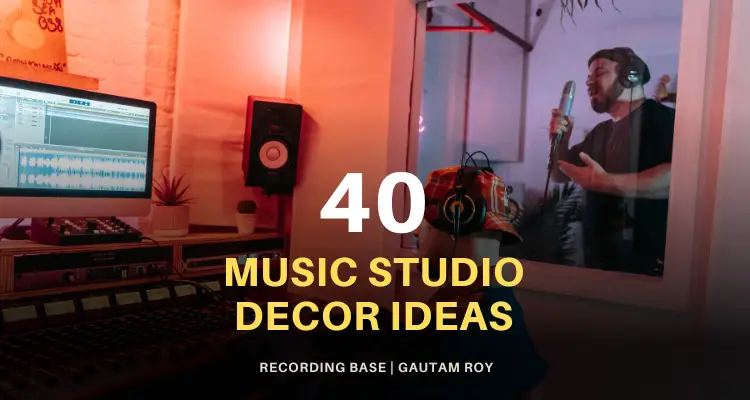
![Top 11 Best Mouse for Music Production in 2024 [Top Picks]](https://www.recordingbase.com/wp-content/uploads/2022/04/best-mouse-for-music-production-home-studios.png)
![Studio Monitor Cables Buying Guide [Top 10 in 2024]](https://www.recordingbase.com/wp-content/uploads/2021/11/Practice-Online-Now.png)



Could you please advice a good mixing rack at an affordable price.
How do get recording equipment shipped to me in my home country Nigeria.